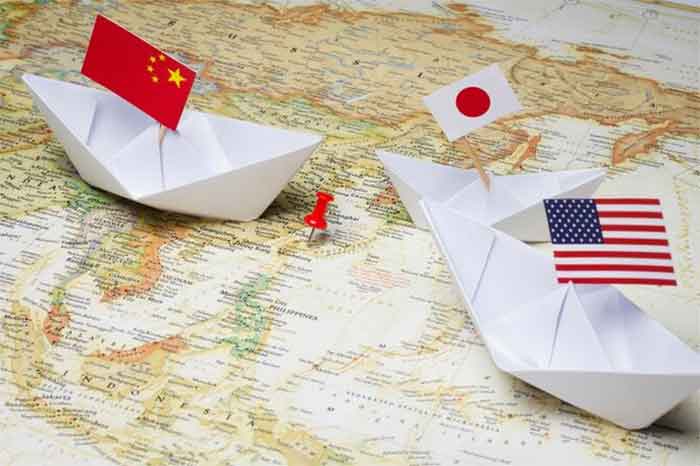
India PM took part on Friday afternoon the White House Quad meeting. His relaxed face with smile and Biden’s hearty open smile in a WH photo can speak volumes. Or? The focussed Quad priorities on the rule of law, navigation and overflight freedom, peaceful resolution of disputes, democratic values and territorial integrity of states and support for smaller states of ASEAN, is a clear message and warning exclusively to China not to flex its muscles anymore and realise its power limitations in Asia. In other words, Biden has succeeded uniquely to push America’s Asian agenda forward. The joint-communiqué released was very carefully worded not to provoke or hurt China, for the simple reason that all the four Quad members some substantial business with China a few members over 3-digit $ billions
For India it is a unique relief that it does not need to worry about a two-front simultaneous war against China and Pakistan, although the Indian military is definitely on the alert and will not take any chance. No wonder China is pretty mad about this new encirclement that it cannot show off its PLA military prowess in Asia that easily as it once thought, not even against Taiwan which it rightfully and legally considers its property. This is a new tough game for China. It is a long drawn out battle of two Titans- World’s No.1 vs. World’s No.2, economies, a battle where there will be no winners. Biden’s optimism-filled U.N.G.A sermon and Pres. Xi’s muted peaceful response despite the discomforting tension created by Biden’s nuc-sub deal with Australia, augmenting a potential nuclear arms race in the Indo-Pacific, showed that there is no alternative to peace in worldly dealings on a mega scale. War of words was deliberately shunned.
Caution & Care
Nevertheless, India needs to be extremely careful in not overplaying this delicate balancing act for several reasons, including that of its membership in BRICS and SCO. China’s troublesome concern about India is indeed genuine, because India could access high-tech weaponry when needed from both Japan and the U.S.. India needs to be very careful, because of Russia that has a strategic nuclear and military partnership with China. If China puts pressure on Russia with its financial clout and Russia pours in top weapons to Pakistan and Pakistan’s ISI starts troubling India with sporadic terror attacks, then India will not have peace. But Russia will warn India before it embarks on one such “ballistic” adventure. Russia is a cool calculator and is not given to haphazard decisions. In fact Russia will try its best to regain India’s friendship and not let India delivered for an all-American ‘Anaconda gulp’. Even today Russia is very hesitant to recognise the Taleban government following a wait-and-see policy like India, even though it has a good working relationship with the Talebans. Kremlin spokesman Dmitry Peskov stated in a Sept.7 briefing that Russia will “very carefully monitor” the Talebans. Russia will never support Taleban’s primitiveness, neither will Pakistan. But Talebans and Pak together can engender nuisance-value terror attacks on India on a continual basis. With the new Quad momentum accelerating and Biden’s assurance that the Indo-U.S. relations are destined to get “stronger, closer and tighter”, Pak PM Imran Khan will not be foolish enough to entrench Pak army into such anti-India terror campaign, as the U.S. would mobilize tough economic sanctions against Pakistan that Pakistan can least afford now. May be even China would discourage Pak not to in order to win back India into the Asian fold. India therefore seems to be awarded a rather mysterious silent game-play, if P.M Modi can exploit it best in national interests.
Enter High-Tech
So far we hear and see only big nice words. Although there is the mention of semiconductor systems’-sharing no concrete technology measures as therapy for India’s dilapidated infrastructures have surfaced. India needs to fight hard with the U.S. and let U.S. micro-electronics companies to invest heavily in India, instead of China in the full cycle of latest crystal growth techniques (modified vertical Bridgman), Chemical Beam Epitaxy (CBE) reactors for sophisticated multi-junction layered chips and sophisticated devices and chip architecture, nanotube devices and GaN (Gallium Nitride) devices. Till now only Honeywell has teamed up with the Tata’s. Where are the rest of the great players like, Motorola, Rockwell, Intel, GE, GM Microelectronics etc.? Japan which uses advanced CBE techniques can invest in India if it wants. Indians have the ability to learn fast. India’s inclusion in the Quad is a welcome opportunity to move forward technologically, eventually even outsmarting China. That would be the West’s legitimate answer to the “invincible China” conundrum. A strengthened India, technologically superior to China, is the best guarantee for democracy to get well-anchored throughout Asia. India too can produce high-tech consumables as cheap as in China that can bolster the spine of smaller Asian nations to do well with a booming market growing that the U.S. and Japanese economies can fully exploit. Don’t forget, India is an English speaking nation. An India push will bloom out the Asian market like no one’s business.
George Chakko, former U.N. correspondent, now retiree in Vienna, Austria.

















































